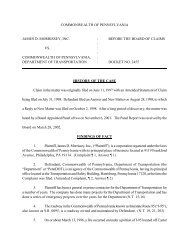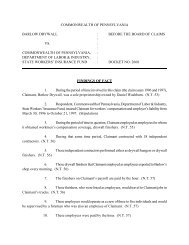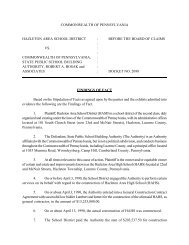3720 - Board of Claims
3720 - Board of Claims
3720 - Board of Claims
Create successful ePaper yourself
Turn your PDF publications into a flip-book with our unique Google optimized e-Paper software.
started to work, it had to finish that section before moving to excavate or build in other sections.<br />
(Ex. P-2A).<br />
298. The construction methods to be used for the embankments were otherwise left to<br />
the contractor. (N.T. 1068, 1160; Ex. P-17).<br />
299. When Intercounty bid the Project, it planned to start construction in Section One<br />
where it needed to construct embankments. To do this, Intercounty’s original excavation plan<br />
was to immediately go to Section Three where it would excavate the material it needed from the<br />
cut areas in the hillside, load the material into dump trucks, and then transport, dump, spread and<br />
compact the material where it was needed in Section One directly and without stockpiling this<br />
material. Later, it planned to build the embankments in Section Two by also going into the<br />
hillside along the Section Three roadway for the material as it was needed and without<br />
rehandling. (N.T. 357-360; 624-626).<br />
300. Intercounty never discussed this original excavation plan for building the<br />
embankments with PennDOT, and never had PennDOT’s approval for this plan. (N.T. 359).<br />
301. Under the original Construction Sequence, Intercounty would not have been able<br />
to use its original excavation plan, but instead would have had to start in Section One by building<br />
the embankments there and would not have been able to excavate any material from Section<br />
Three until much later. (N.T. 357-359; Ex. P-2A; <strong>Board</strong> Finding).<br />
302. Pursuant to the 408 Specifications, Intercounty would have had to purchase fill<br />
material <strong>of</strong>fsite, truck it to the site and <strong>of</strong>f-load it to create the Section One embankments. The<br />
same would have been true for Section Two. (N.T. 357-360; Exs. P-2A, P-59, P-60; F.O.F. <br />
291-301; <strong>Board</strong> Finding).<br />
303. When it got to Section Three, Intercounty would have had to excavate the hillside<br />
and pay substantial costs for hauling and disposing <strong>of</strong> that material <strong>of</strong>fsite. (N.T. 357-360; Exs.<br />
P-2A, P-59, P-60; F.O.F. 291-301; <strong>Board</strong> Finding).<br />
304. The <strong>Board</strong> finds that Intercounty’s claim that the re-handling costs were “extra<br />
costs” caused by the “flip” in the Construction Sequence is a flawed theory <strong>of</strong> recovery because<br />
it was premised on its plan for doing the work that would not have been permitted under the<br />
original Construction Sequence. (N.T. 357-359; F.O.F. 289-303; <strong>Board</strong> Finding).<br />
305. When the Construction Sequence was flipped at the beginning <strong>of</strong> work on the<br />
Project, Intercounty started with the hillside excavation in Section Three and, as per the original<br />
Construction Sequence, was restricted to completing that section before creating any<br />
embankments in other sections. (N.T. 357-359; Ex. P-2A).<br />
306. Because Intercounty stockpiled the Section Three material as directed by<br />
PennDOT, Intercounty did not have to purchase fill <strong>of</strong>fsite and truck it in to construct the Section<br />
One and Two embankments. By using the stockpiled material, it saved the costs <strong>of</strong> significant<br />
“borrow” material. (F.O.F. 289-305; <strong>Board</strong> Finding).<br />
39






